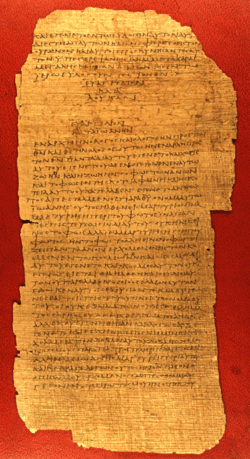John 1
| John 1 | |
|---|---|
|
John 1:21-28 on Papyrus 119, written about AD 250. | |
| Book | Gospel of John |
| Bible part | New Testament |
| Order in the Bible part | 4 |
| Category | Gospel |
| Gospel of John |
|---|
John 1 is the first chapter in the Gospel of John in the New Testament of the Christian Bible. The book containing this chapter is anonymous but early Christian tradition uniformly affirmed that John composed this Gospel.[1]


Text
- The original text is written in Koine Greek.
- Some most ancient manuscripts containing this chapter are:
- Papyrus 75 (written about AD 175-225)
- Papyrus 66 (AD 200; complete)
- Papyrus 5 and Papyrus 119 (both written ca. AD 250)
- Papyrus 106 (3rd century)
- Codex Vaticanus (ca. AD 325-350)
- Codex Sinaiticus (ca. AD 350; complete)
- Papyrus 120 (4th century)
- Codex Bezae (ca. AD 400)
- Codex Washingtonianus (ca. AD 400)
- Codex Alexandrinus (ca. AD 400-440; almost complete)
- Codex Ephraemi Rescriptus (ca. AD 450; extant: verses 4-40)
- Codex Borgianus (5th century; extant: verses 24-32 (Greek); 16-23 (Coptic Sahidic))
- This chapter is divided into 51 verses.
Analysis
The first chapter of the Gospel of John can be divided in two parts:
The first part (v. 1-18) is an introduction to the Gospel as a whole, stating that the Logos is "God" (divine, god-like, a god[2] according to other translations) and acts as the mouthpiece (Word) of God "made flesh", i.e. sent to the world in order to be able to intercede for man and forgive him his sins (The Good News of the Gospel). This portion of John's gospel is of central significance to the development of the Christian doctrine of Incarnation. Comparisons can easily be drawn from this part to Genesis 1 where the same phrase In the beginning first occurs along with the emphasis on the difference between the darkness (such as the earth was formless and void, Genesis 1:2) vs light (the ability to see things not understood/hidden by the darkness, John 1:5). The summation of this comparison occurs in the statement, the law given through Moses... grace and truth came through Jesus Christ (John 1:17). Here John successfully bridges the gap for the reader – including Jewish readers well-versed in the Torah – from the Law to the One who would fulfill the Law (such as the requirement of animal sacrifice for the forgiveness of sins, Hebrews 9:22), Jesus.


The second part (v. 19-50) shows the preparation that John the Baptist was in the process of doing for the coming of the Messiah, the Messiah's arrival and the Messiah's first disciples. First, John consistently denies being the Light himself and instead to be making the way for the Light to come (v. 19-28). John the Baptist then reveals that when the One comes he would be unfit to even so much as untie his sandals – let alone baptize Him like the many he had up to that point. No sooner than the next day the Messiah appears before John the Baptist and he then acknowledges Jesus as the Lamb of God (v. 35) of whom he spoke. As the chapter progresses further Jesus picks his first disciples and changes Simon's name to Cephas (Peter). Cephas, original word Κηφᾶς, means "rock" This provided a powerful analogy as to the role Peter would have after the crucifixion and be the lead the development of the church. Name changes occur other places in the Bible and demonstrate God's authority as well as what that person would become/do/ or had done, such as Abram to Abraham and Jacob to Israel. Jesus' first active sign of power was to Nathaniel who was thoroughly impressed by Jesus' foreknowledge of his personal character.
References
- ↑ Holman Illustrated Bible Handbook. Holman Bible Publishers, Nashville, Tennessee. 2012.
- ↑ Duff, Jeremy, The Elements of New Testament Greek - 3rd ed., Cambridge University Press, 2005. ISBN 0-521-75550-6. "[W]e can't tell if the author meant the word was θεός [a god] or ό θεός [God]," says in p. 63, ft. 3.
| Wikisource has original text related to this article: |
| Preceded by Luke 24 |
Chapters of the Bible Gospel of John |
Succeeded by John 2 |
